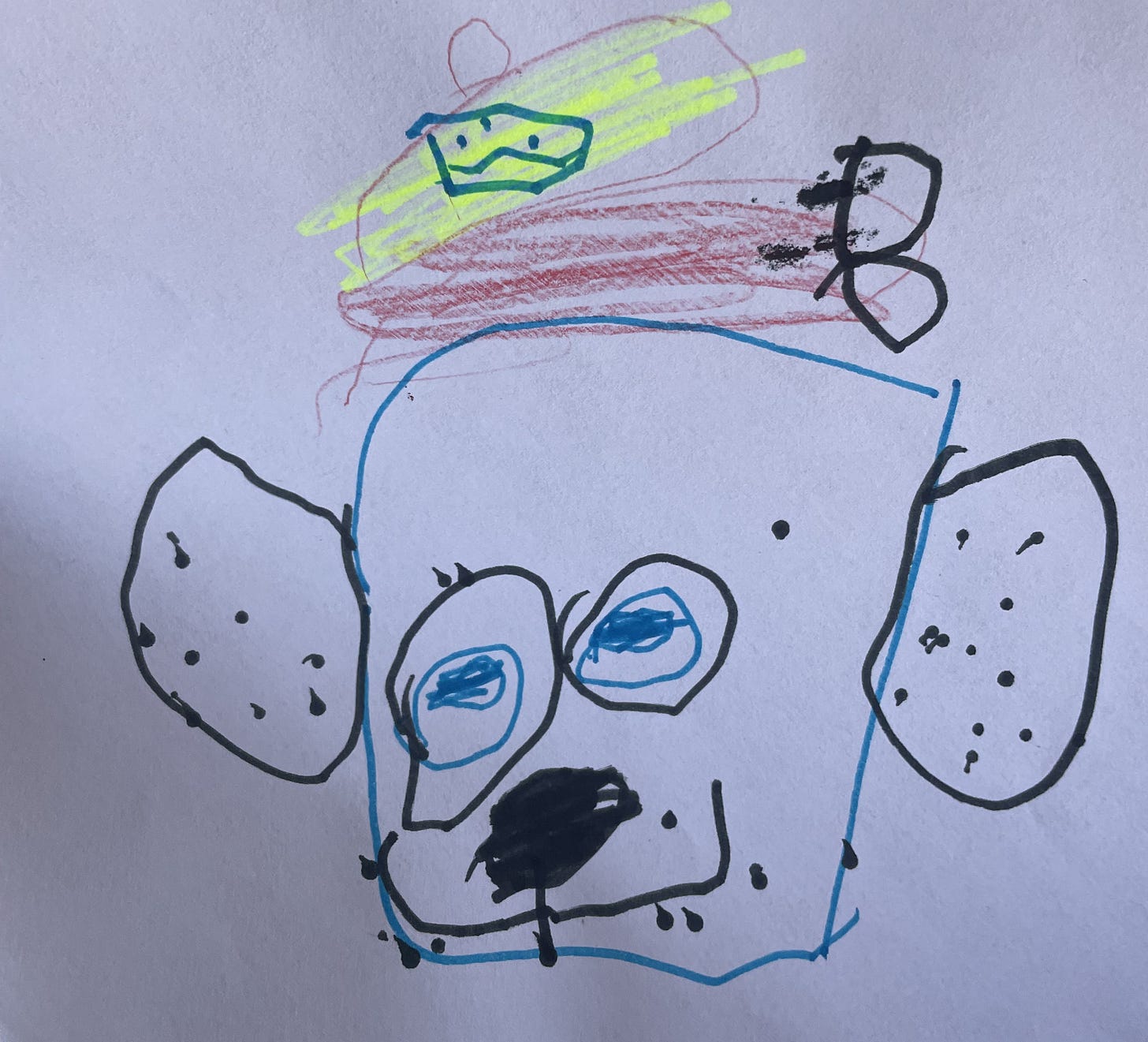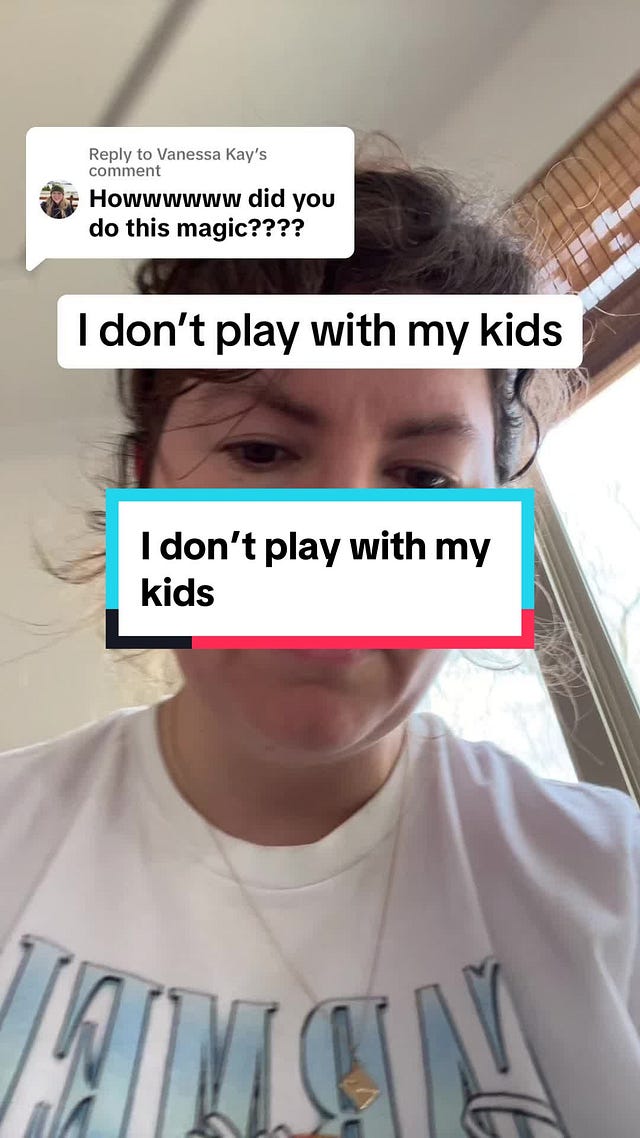If you are new here, welcome to Dr. Amber_Writes. I am a clinical psychologist that writes weekly about mental health. I aim to bring you evidenced-based information, with a personal touch. If you want to hear from me again, subscribe any time.

With all these articles I am writing about Tik-Tok, you might mistake me for being “chronically online”, as the kids say. Let me assure you that I miss most of the good drama because I’m mostly watching videos about houseplants or weird pets (like this person who buries and digs up her pet turtles every year. Who knew?!)
But I am weighing in on this one because I just happened to be watching it play out in real time. Therapist and author KC Davis1 is the creator of the very popular Tik-Tok account DomesticBlisters. Davis’s platform is mostly about destigmatizing mental health challenges and offering practical suggestions for completing responsibilities of daily living, when you are struggling with depression, anxiety, ADHD, etc.
Earlier this week, Davis posted a now viral video stating that she does not “play” with her young children, because she does not enjoy it. Since nothing stirs up an angry mob faster than a mother just trying to survive, the internet did not respond kindly.

 Tiktok failed to load.
Tiktok failed to load.Enable 3rd party cookies or use another browser
Some people recalled feeling lonely in childhood because their parents did not play with them. Others highlighted that children communicate through play; therefore, denying play is denying important connection. It was repeatedly stated that play is developmentally critical for children, and it is part of a parent’s job to provide play opportunities. Some commenters love playing with their children, so of course everyone should be more like them.
So what’s the verdict? Must parents play with their children?
The answer is, “Yes, and…”
Just to be clear, Davis was talking specifically about one type of playful activity, “imaginary play.” She is talking about playing make-believe; the type of play that involves making voices and acting out storylines with Barbie Dolls or Paw Patrol characters. She repeatedly stated that she spends ample time in other activities with her kids, like arts and crafts, being outside, science experiments, and engaging them in household tasks. She plays with them, but she does not play “make believe.” Notably, she has two young children who can assumedly play with one another.
In 2018, the American Academy of Pediatrics released a report on the positive impacts of play on child development. It states, “The definition of play is elusive. However, there is a growing consensus that it is an activity that is intrinsically motivated, entails active engagement, and results in joyful discovery. Play is voluntary and often has no extrinsic goals; it is fun and often spontaneous.” It describes play as critical to the development of problem-solving, social skills, and executive-functioning skills that underly more advanced skills needed in adulthood.
The report describes different types of play, including “rough and tumble” play, play that uses toys, and outside play2. The imaginary play that Davis is referring to falls under the domain of “social play”, which is especially important for the development of language and social identity.
Some play is completely guided by the child, while some is more structured like board games and puzzles. A balance of both types is important.
Notably, the Pediatrics report includes a chart of dozens of play activities recommended for children birth through age 6, and only a couple of those activities refer to “imaginary play.” I think it is fair to say that parents can support their children in meeting their daily quota of play without having to sit on the floor and act out scenes from Paw Patrol. Social play should encourage language, reciprocal communication, and the opportunity to “try on” different social roles.
Children need to feel connected with their parents, and this involves showing interest in what our kids care about, listening to them, and teaching them. Imaginary play is one way to do these things, but not the only way. All of the activities Davis mentions are also playful ways to connect with children, and can easily incorporate imagination, communication, and creativity just as effectively as any game of make-believe.
Parents are unique. Children are unique. And every parent-child dyad is unique. There is no one tried and true way for all families to behave and interact. What works for any one child is going to depend on the child’s temperament, strengths, and preferences. It will be influenced by numerous factors on the individual, family, and societal levels. Play will look different in different cultures just as it has looked different across generations.
Children need playful interaction with the adults in their lives. You know what else benefits children? Having healthy and well-balanced parents. There has been a cultural shift towards a parenting style that is more time-intensive and child-focused meaning the pressure on parents is at an all time high. Parents are expected to be more present, more engaged, and more knowledgeable now than ever before.
Anecdotally, many mothers are speaking about the pressures they feel to meet the demands of modern parenthood, especially since most families need both parents to work outside the home in order to make ends meet. When kids can play independently, it allows parents the opportunity to take a breath (or do a chore). On Davis’s video, in addition to the criticism, there were many mothers who shared immense relief and validation at being given a different perspective on how to play with their children. No loving, well-intentioned parent deserves to be feeling guilt for not playing with their child the “right way.” This guilt contributes to the emotional burden on parents, taking a toll on mental health that harms both parents and children.
Almost universally, parents want to do what is best for their children. My message to parents who hate imaginary play? Turn your attention towards activities that you actually enjoy doing with your kids. You will be most effective when you are engaging with genuine enjoyment and appreciation of your time together. In addition, actively teach and encourage independent play, whether that be with toys, games, or outdoor activity. When kids are not taught and encouraged to play independently, they may be more likely to turn to fast and easy entertainment, like tablets and video games, when parents are not available to entertain them.
If you are still worried about whether or not you are providing quality play time with your child, focus on setting aside 15 minutes a day for unstructured, child-led playtime. Let your child decide what to play and refrain from giving them instructions or making suggestions (besides those needed to enforce safety of course). When it is time to wrap up playtime, tell your child clearly that you are done playing; give them the option to continue independently or joining you in a different, parent-led activity.
Parents, how do you feel about imaginary play-time? I would love to hear your thoughts in the comments. If this article was interesting, please like or share to help my work reach a broader audience.
Disclosure: Dr. Amber_Writes is a newsletter designed to be informational, entertaining, and engaging. It is not therapy. Following this newsletter does not establish a therapeutic relationship with me. Dr. Amber_Writes, and other written communication by Amber Groomes on Substack, is not a substitute for treatment, diagnosis, or consultation with a licensed mental health professional. I assume no liability for any action taken in reliance on my writing here at Dr. Amber_Writes.
You can check out KC Davis on her website called Struggle Care. It has tons of resources to support individuals struggling with tasks of self and home care.
The Power of Play: A Pediatric Role in Enhancing Development in Young Children by the American Academy of Pediatrics





I don't mind imaginary play, so long as my children let me decide what my own character is going to do next, which they often don't. It quickly becomes a bit tedious when they're mapping out all the things my character is and isn't allowed to do...
I do a lot of building with my older two. We have a storage tower in our living room with four big boxes, each containing a different building toy (lego, duplo, magnatiles and sticklebricks.) Often, if the imaginative play with their figures is getting to the point I've described above, I'll suggest we build a house for the characters to live in or a play centre for them etc - the kids love it and we treat it as an extension of our game without me showing outright that I'm getting bored. Sometimes while they're busy having the figures talk to one another I'll just continue building whilst making enthusiastic statements now and then, which they're happy with
That was a long tangent I didn't know I was going to go on, but to shorten it - I do think play is important, but I think we need to find ways that make it bearable for us if the games they want us to play don't always come naturally. Something I have on my side also is having two boys that are only 19 months apart. We'll see how easily I can get out of it when the youngest reaches this stage
So glad you wrote this nuanced, fleshed out piece. 🙏🏼🙏🏼